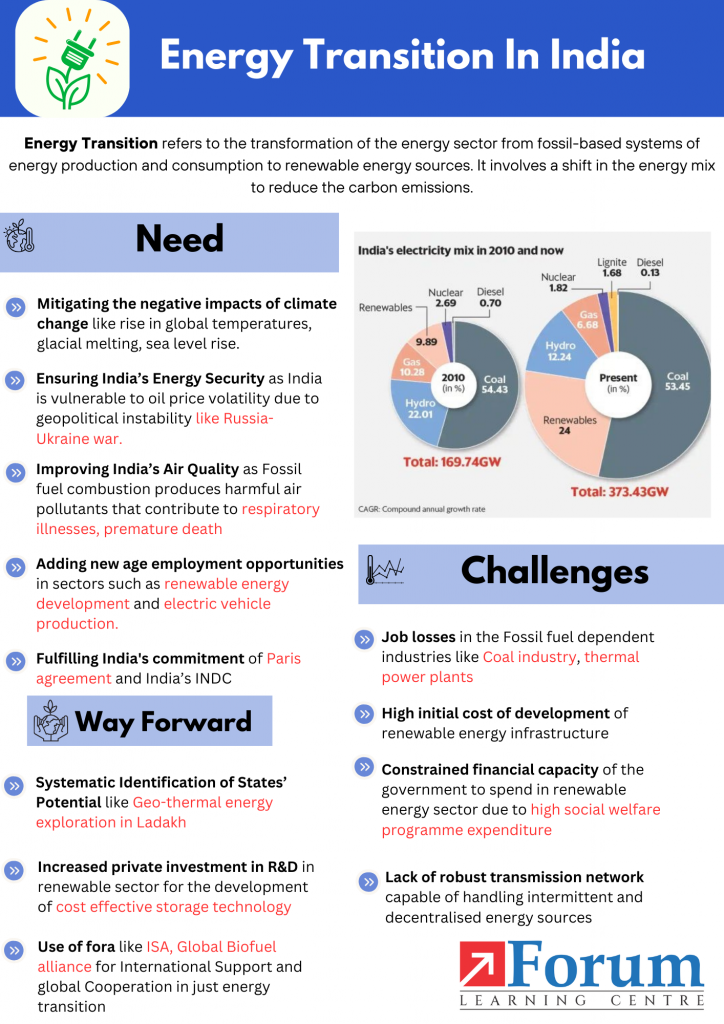Energy Transition in India, from conventional to renewable sources of electricity generation, has been a transformative journey. This energy transition journey marks a monumental step towards a sustainable energy future. The Government’s unwavering commitment to ambitious renewable energy targets, coupled with innovative policies and incentives, has set the stage for a greener energy landscape.
Energy Transition in India Info graph for Quick Read

What is Energy Transition and what is the status of Energy Transition in India?
Energy Transition refers to the transformation of the energy sector from fossil-based systems of energy production and consumption to renewable energy sources. It involves a shift in the energy mix to reduce the carbon emissions.
Energy Transition Status of India
| Target of renewable energy installation (by 2022) | 175 GW |
| Installed renewable energy capacity (Till FY 22) | 172 GW |
| Percentage increase in RE capacity from FY 2014 to FY 2023 | 17.2% (2014) 22.5% (2023) |
| India’s Global Rank in installed RE capacity | 4th |
New Energy Transition Targets for India
| Panchamrit- Five Nector of India’s climate action 1. Reach 500GW Non-fossil energy capacity by 2030. 2. 50 per cent of India’s energy requirements to be met by renewable energy by 2030. 3. Reduction of total projected carbon emissions by one billion tonnes from now to 2030. 4. Reduction of the carbon intensity of the economy by 45 per cent by 2030, over 2005 levels. 5. Achieving the target of net zero emissions by 2070. Read More- India’s New Climate Targets (INDCs) – Explained, pointwise |
What is the need for energy transition in India?
1. Mitigating the negative impacts of climate change- Fossil fuel driven energy sector has resulted in increase in industrial emissions, causing threats of extreme climate change events like rise in global temperatures, glacial melting, sea level rise, heatwaves, cyclones and floods.
2. Energy Security- The reliance on fossil fuels has made India vulnerable to price volatility and geopolitical instability. For ex- Oil prices increase due to Russia-Ukraine war, Gulf war.
3. Improving Air Quality- Fossil fuel combustion produces harmful air pollutants that contribute to respiratory illnesses, premature death, and environmental damage.
4. Economic Opportunities- Energy transition in India has added new age employment opportunities and spurred economic growth in sectors such as renewable energy development, energy efficiency and electric vehicle production.
5. Fulfilment of India’s commitment- Energy transition measures help in fulfilment of India’s commitment at Paris Agreement.
What steps have been taken by India towards Energy Transition?
The Government of India has taken several measures for India’s energy transition. Some of them are mentioned below-
| Energy Conservation (Amendment) Act 2022 | Energy Conservation Amendment Act, 2022 aims to mandate the use of non-fossil fuel sources including green hydrogen, green ammonia, biomass and ethanol for energy and feedstock in industries. |
| Renewable Purchase Obligations (RPO) | All electricity distribution licensees should purchase or produce a minimum specified quantity of their requirements from Renewable Energy Sources. |
| National Solar Mission | An initiative of the Government of India and State Governments to promote solar power in India with the target of target of 100 GW of solar power by 2022. |
| National Policy on Biofuels | The policy’s objective is to reduce the import of petroleum products by fostering domestic biofuel production. |
| National Green Hydrogen Mission | National Green Hydrogen Mission was launched to make India a leading producer and supplier of Green Hydrogen in the world. |
What are the challenges to Energy Transition ?
1. Fossil-Dependent Jobs- The shift away from fossil fuels may result in job losses, which can be disruptive for affected communities and workers. For ex- Job losses in the coal production sector.
2. Cost and Infrastructure- The initial cost of transitioning to renewable energy is very high. The availability of land for renewable projects has also been one of the major challenges in India’s energy transition.
3. State’s expenditure on Welfare Programmes- Government’s focus on welfare programmes such as healthcare, education, and housing assistance, etc has limited its capacity to invest in new energy infrastructure and technology.
4. Energy Storage- Power generated through solar and wind energy is intermittent and poses challenges in grid stability and load balancing. India lack’s the storage technology like stro for renewable energy.
5. Transmission Networks- India lacks a robust transmission network capable of handling intermittent and decentralised energy sources, which is crucial to maintaining grid stability and reliability.
Conclusion and Way Forward
1. Systematic Identification of States’ Potential- States with the potential of contributing to RE installations and the 2030 clean energy transition goal need to be identified and leveraged systematically. For ex- Geothermal energy being explored in Ladakh.
2. Increased private investment in R&D in renewable sector- India should draft policies to attract more FDI in renewable energy sector, which will help in the development of better storage cells and transmission sector.
3. International Support and global Cooperation- India must use fora like ISA, Global Biofuel alliance to mobilise international capital and technical expertise for the renewable energy sector.
4. Alternate Livelihood Opportunities- People employed in fossil fuel based energy systems (coal mines, power plants etc.) will be losing their jobs as a result of energy transition. They will need to be retrained and provided with new employment opportunities as quickly as possible.
5. Proper planning and monitoring- Realistic transmission and Renewable Energy project planning coupled with regular monitoring and remedial actions are needed to achieve the targets.
Energy Transition is the most vital aspect of shift towards green and sustainable economic systems. However, there are several challenges that may derail the transition. There is a need for greater efforts in terms of financial support and technology sharing to ensure that the process of energy transition is equitable and least disruptive.
| Source- The Hindu Syllabus- GS III Infrastructure: Energy; GS III, Conservation. |
Discover more from Free UPSC IAS Preparation Syllabus and Materials For Aspirants
Subscribe to get the latest posts sent to your email.







